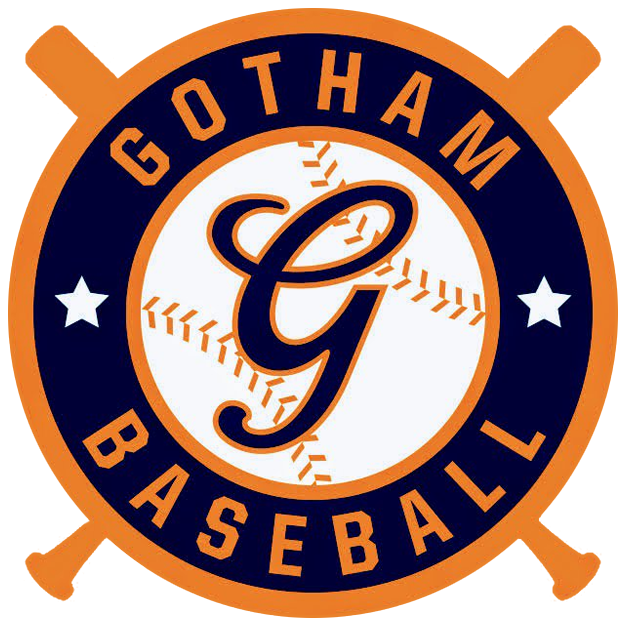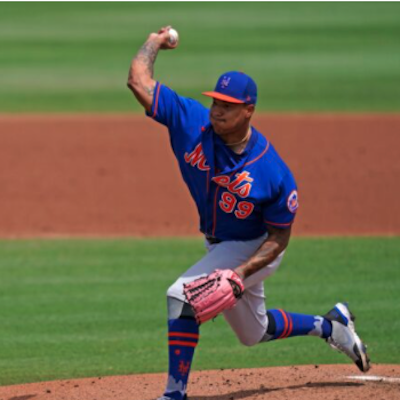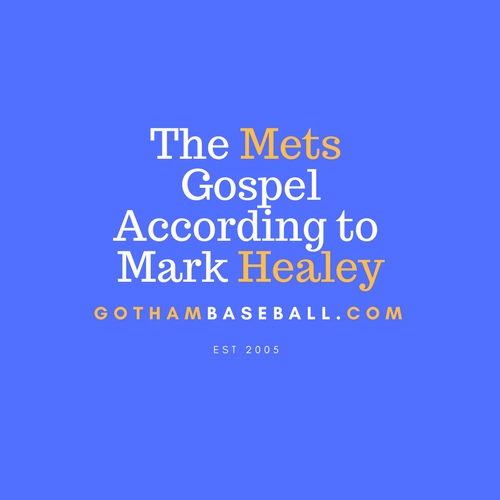Despite a frustrating loss on Sunday, the Mets closed out the first half* of the season in first place. This was an optimistic expectation by many Mets fans from the moment that Steve Cohen took over ownership of the team. Still, the cast of characters that got them here are not the names that many wanted to see.
This past offseason was highly anticipated throughout baseball. While there were many quality free agents available, there were five in particular who were considered potential difference-makers: Trevor Bauer, George Springer, JT Realmuto, DJ LeMahieu, and Marcell Ozuna. When Steve Cohen officially became the Mets owner last November, it didn’t take long for fans to start envisioning each of those players wearing orange and blue. While some debated which of those players would join the Mets, many fantasized two or more of them making the move to Queens. In the end, as you probably know, the Mets landed none of them. Let’s take a look at how those players have fared so far this season and, while we’re at it, let’s take a look at the players the Mets wound up with instead.
Before we do though, I have to make a very clear point. As I have mentioned in previous explorations like this, I am not suggesting that these are the stats that these players would have if they were on the Mets. There are so many factors that go into determining an outcome in baseball, that basic numbers are not automatically transferable. Additionally, I do subscribe to the butterfly effect, and if any of these players had done even the slightest thing differently, things could have played out in any number of unpredictable ways.
Realmuto: Most baseball followers, from high-level scouts to the casual fan, felt pretty comfortable declaring that JT Realmuto was not only the best catcher available in free agency, he was also the best catcher in the majors. While that latter point could be somewhat debatable, the former was about as close to fact as an opinion could be. As it turns out, Realmuto’s 2021 performance is on par with expectations. His .813 OPS is right around where it’s been the last few non-COVID seasons, and while his power numbers are down slightly he’s getting on base more, and he was an obvious choice to make the All-Star team. The Mets chose to pursue James McCann instead of Realmuto, not because they thought McCann was better, but because they didn’t want to risk the opportunity to improve at catcher, and signing Realmuto was no sure thing. Additionally, they were able to sign McCann in mid-December, the first of their major moves, while Realmuto didn’t agree to return to Philadelphia until the end of January. Still, when comparing Realmuto to McCann, while there is a drop off in terms of offensive production, it may not be as significant as one might think. In nearly the same number of plate appearance (Realmuto – 272, McCann – 254), Realmuto is batting .268 with 8 HRs, 33 RBIs, 33 runs scored, and the previously indicated .813 OPS. This comes out to a WAR (Wins Above Replacement) of 1.9. McCann is batting .253 with 7 HRs, 19 runs scored, and a disappointing .703 OPS. This comes out a 0.9 WAR. Realmuto is clearly having a superior season, especially when it comes to the all important OPS, hence his All-Star status. Still, McCann was never expected to be better than Realmuto and his signing paved the way for other Mets improvements that may not have happened had they chased after Realmuto.
LeMahieu: It feels a little silly analyzing this one. Despite a couple weeks’ worth of reports exploring other teams’ interest in LeMahieu (including the Mets and the Blue Jays), it seemed a forgone conclusion that LeMahieu would return to the Yankees. Even though it took a while to come to fruition, when LeMahieu signed with the Yankees at the end of January (two days before Realmuto signed with the Phillies) it seemed more like a confirmation than news. Still, there was a moment when LeMahieu appeared on the Mets radar, before they ultimately decided to trade for Francisco Lindor. I’ve been hesitant to get too caught up in Lindor’s 2021 shortcomings. Every time the guy strings together a couple hits, there’s a hope-laced belief that he’s about to become the Lindor the Mets thought they were getting. Still, we’re at the All-Star break and Lindor’s numbers have been a letdown. Truthfully, there are some other aspects of Lindor’s game that the numbers don’t really show (although I’m sure someone Bill James knows can come with a stat for them), and I think he’s been a key reason for the Mets success so far. Still, the player he’s been hasn’t warranted his Sports Illustrated Baseball Preview cover status. Similarly, for most of 2021, DJ LeMahieu has been a disappointment. His stats are quite a drop-off from his previous Yankees seasons, and his production so far has been rather pedestrian. So, even though it was never all that realistic to expect LeMahieu to join the Mets infield, here is a quick comparison: In 381 plate appearances, LeMahieu is batting .271 with 7HRs, 36 RBIs, 46 runs scored, 3 stolen bases, a OPS, and a 0.9 WAR. Meanwhile, Lindor, after 356 plate appearances, is batting .220 with 10 HRs, 34 RBIs. 48 runs scored, 8 stolen bases, a OPS, and a 2.0 WAR. I’m guessing that Lindor’s higher WAR is due to his impressive fielding metrics. Time will tell if the Mets commitment to Lindor was a wise decision. As for LeMahieu, it would probably have required the Mets to significantly overpay him to convince him to come to Flushing, and apparently the results would have been far from a sure thing.
Ozuna: Much like the LeMahieu situation, it was never all that likely that Ozuna was going to join the Mets. They were reportedly in on him at some point, because they were reportedly in on just about everyone at some point. While the Mets were considering making improvements to their outfielders, Ozuna’s ability with the bat is often offset by his subpar fielding. Even Ozuna’s batting results have never really been much of a guarantee. Since his rookie season in 2013, Ozuna has been more about potential than results. He did have an impressive showing in his walk year with the Marlins in 2017. Similarly, last year, another walk year albeit a COVID-shortened one, he had his best season to date. In the end, the Mets opted not to pursue Ozuna, first focusing their efforts on George Springer (more about him in a moment) and then ultimately deciding to shore up their outfield depth, which has proven to be an important step. Ozuna, meanwhile, suffered an injury to his hand (a couple broken fingers), at the end of May, capping off two incredibly disappointing months of baseball. More importantly, while on the injured list, Ozuna was arrested for two counts of domestic violence, aggravated assault strangulation (a felony) and battery (a misdemeanor) following an incident with his wife. The police investigation and the MLB investigation are ongoing. Working under the notion of innocent until proven guilty, this is an unstable situation at best. If, indeed, Ozuna is guilty, then this is a horrifying matter. From a (much less important) baseball view, Ozuna appears on track to miss significant time as a suspension is entirely possible, and the Mets should feel fortunate to have avoided dealing with this.
Springer: I really thought this was the player the Mets should have been targeting from day one. In fact, I spent much of November, December, and the first few weeks of January, checking the internet multiple times per day for any news on Springer. Once some of the initial teams that were in on Springer fell out of the running, I really thought it was going to happen. In the end, it didn’t. Springer signed with the Toronto/Buffalo/Dunedin Blue Jays for 6 years/$150 million, and put my plans for the Mets (and possibly theirs) back to square one. I’ve never been particularly proud of my inability to quantify a player’s performance into a salary. It was understood that whoever signed Springer would be overpaying for him, to some degree. Ultimately, it seems that the length of the contract, rather than the annual salary, was the determining factor for the Mets. Even though it was an understandable stance, it was still incredibly disappointing. As I wrote before, after missing out on Springer, the Mets turned their focus to improving their outfield depth, signing Albert Almora and Kevin Pillar instead. As consolation prizes go, I hardly viewed this as consoling, especially at the time. Then, during spring training Springer was diagnosed with a Grade 2 oblique strain. In case you were wondering, oblique strain cases are divided into 3 grades: mild (1), moderate (2), severe (3). While Grade 3 suggests a ruptured muscle, any of these distinctions comes with a range of outcomes. In other words, even a player with a mild strain can miss some fairly significant time. In Springer’s case, despite some initial indications otherwise, he missed opening day and was on track to return to the Blue Jays in the second week of the season. Then, during an early-April simulated game, Springer felt some tightness in his right quad and was diagnosed with a low grade strain there. The strains on his body may have been determined to be mild-to-moderate, but the strains on the fans who were anticipating seeing him contribute were rather sizable. Springer finally made his Blue Jays debut on April 28th, 4 weeks into the season. Then after 4 games with the Jays, Springer was held out of the lineup, initially due to “fatigue”, although it was later revealed that the quad strain had not fully healed. A couple days later, Springer returned to the injured list, and didn’t make it back to the Blue Jays outfield for another 7 weeks. All in all, as baseball heads into the All-Star break, Springer has played in only 20 games, and is batting only .194, with a .726 OPS, and a bunch of other paltry stats. So, you know, perhaps I was wrong.
Bauer: My thoughts on Trevor Bauer this offseason differed dramatically from my thoughts on Springer. Everything about Trevor Bauer is hard to ignore. He won the Cy Young award last year, and deservedly so. His stats were impressive. At the same time, he hasn’t always been great. In fact, prior to last season, he had mostly been pretty good. Since coming up to the majors in 2012, he had shown potential for really good-ness, but had only really put it together for one season (2018). Last year, something stuck, and he turned it into an award-winning season. As the adage goes, “You can never have too much pitching”, so when a pitcher who was just deemed the best in his league enters free agency in the prime of his career, he is going to be highly sought after. Simultaneously, Bauer’s off-the-field behavior has been viewed as divisive, at best, and concerning, at not-so-best. While some have found his outspoken approach to be entertaining, how it would play with the New York media was something to consider. Well, it was something that I considered, enough that it made me not especially keen on seeing the Mets chase after him. The Mets, on the other hand, were more focused on his pitching. I get it. Adding Bauer to a rotation that would have Jacob deGrom, Marcus Stroman, Carlos Carrasco (eventually), and Noah Syndergaard (eventually?), seemed like potential for all-time greatness, let alone 2021 success. The team’s pursuit of Bauer was so strong that, by all accounts I’ve read, they made the most aggressive offer. Ultimately, just as pitchers and catchers were about to report, Bauer turned the Mets offer down and joined the Los Angeles Dodgers, for a slightly less aggressive deal. The Mets felt spurned, while I felt relieved, for the most part. Then, a week and a half later, the Mets signed Taijuan Walker instead. At the time, I gave this move a shoulder shrug and a “we’ll see” kind of reaction. For the first 3 months of the season, Bauer had been quite good. In 17 starts, he had an 8-5 record, a 2.59 ERA, a 1.00 WHIP, and 137 K’s in only 107.2 innings. This is really quite good. Because Bauer’s salary is so huge, I can’t quite say the Dodgers were getting their money’s worth, however they thought they signed a top-of-the-rotation guy, and that’s what they were getting. Then, something happened…in late June, Los Angeles police opened an investigation, after a woman claimed that Bauer sexually assaulted her earlier this year. MLB subsequently placed Bauer on administrative leave and he hasn’t pitched since. Much like the Ozuna situation I mentioned above, I’ll consider Bauer innocent until proven otherwise. Even so, the idea that Bauer is missing time due to non-baseball-related circumstances is sadly unsurprising. Meanwhile, Taijuan Walker has been one of the best stories out of Mets world this season. He’s 7-3 with a 2.50 ERA, a 1.03 WHIP, and 89 K’s in 90 innings. Beyond the stats, he seems to have fit in perfectly with the culture in the Mets clubhouse. When deGrom announced that he would not be attending this year’s All-Star Game in Colorado, he lobbied for Walker to take his place. He got his wish, and Walker will represent the Mets on Tuesday night.
At one point or another this past offseason, the Mets were rumored to be considering each of the 5 top free agents. Instead of coming to the Mets, they went to the Phillies, Yankees, Braves, Blue Jays, and Dodgers. Not one of those teams is in first place today. The Mets are. I guess there are reasons ya gotta believe.
*The season is actually more than halfway done, however the games prior to the All-Star break are generally considered the “first half” so I’m going with that.


